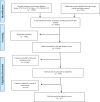Climate adaptive hospital: A systematic review of determinants and actions
- PMID: 36406601
- PMCID: PMC9672300
- DOI: 10.1007/s40201-022-00810-5
Climate adaptive hospital: A systematic review of determinants and actions
Abstract
Introduction: Climate change is among the most renowned concerns of the current century, endangering the lives of millions of people worldwide. To comply with the United Nations Climate Change Conference (COP21), hospitals should be on track to reduce greenhouse gas emissions. Although hospitals contribute to climate change by emitting greenhouse gases, they are also affected by the health consequences of climate change. Despite all the guidance provided, hospitals need more radical measures to confront climate change. The current study was carried out to examine the components of hospitals' adaptation to climate change and to review measures to confront climate change in hospitals.
Method: This systematic review was designed and carried out in 2020. The required information was collected from international electronic databases including Scopus, PubMed, Web of Science, EMBASE, and Google Scholar. Moreover, Iranian datasets such as Scientific Database (SID), Irandoc, Magiran, and IranMedex were reviewed. No restriction was considered in the methodology of the study. For the relevant thesis, the ProQuest database was also explored. The related sources were examined and the Snowball method was applied to find additional related studies. The research team also reviewed other accessible electronic resources, such as international guidelines and academic websites. The checklist of the Joanna Briggs Institute (JBI, 2017) was employed in order to evaluate the quality of the included papers. The studies published until June1, 2020, were included in the study.
Results: Of 11,680 published documents in the initial search, the full-texts of 140 were read after evaluating the titles and abstracts, of which 114 were excluded due to lack of sufficient information related to countermeasures in hospitals. Finally, the full-texts of 26 studies were reviewed to extract the required components. Two strategies were found, including climate change mitigation and climate change adaptation, with 13 components including water, wastewater, energy, waste, green buildings, food, transportation, green purchasing policy, medicines, chemicals and toxins, technology, sustainable care models, and leadership in hospitals were identified as affecting these measures and strategies.
Conclusion: Considering the significance of climate change and strategies to confront it as one of the current challenges and priorities in the world, it is necessary to develop a framework and model to reduce the effects of climate change and adapt to climate changes in hospitals and other health centers. The identification and classification of the measures and components, influencing hospital adaptability and solutions for reducing the climate change impacts could be the first stage in developing this strategy. This is because it is impossible to create this framework without identifying these factors and their mutual impacts at the first. In the present study, through a systematic review using a comprehensive approach, the related components were explored and divided into two categories, including measures to reduce the effects and measures to adapt to climate change. The results of this study can be useful in developing a comprehensive action model to reduce greenhouse gas emissions and adapt hospitals to climate change.
Keywords: Adaptation; Climate change; Hospital; Mitigation; Strategy.
© The Author(s), under exclusive licence to Tehran University of Medical Sciences 2022.
Conflict of interest statement
Conflict of interestThe authors declare that they have no conflict of interest.
Figures
Similar articles
-
The Effectiveness of Integrated Care Pathways for Adults and Children in Health Care Settings: A Systematic Review.JBI Libr Syst Rev. 2009;7(3):80-129. doi: 10.11124/01938924-200907030-00001. JBI Libr Syst Rev. 2009. PMID: 27820426
-
Beyond the black stump: rapid reviews of health research issues affecting regional, rural and remote Australia.Med J Aust. 2020 Dec;213 Suppl 11:S3-S32.e1. doi: 10.5694/mja2.50881. Med J Aust. 2020. PMID: 33314144
-
Hospital climate actions and assessment tools: a scoping review protocol.BMJ Open. 2019 Dec 29;9(12):e032561. doi: 10.1136/bmjopen-2019-032561. BMJ Open. 2019. PMID: 31888929 Free PMC article.
-
Planetary Health and Hospitals' Contribution-A Scoping Review.Int J Environ Res Public Health. 2022 Oct 19;19(20):13536. doi: 10.3390/ijerph192013536. Int J Environ Res Public Health. 2022. PMID: 36294116 Free PMC article.
-
Nexus of food waste and climate change framework: Unravelling the links between impacts, projections, and emissions.Environ Pollut. 2024 Mar 1;344:123387. doi: 10.1016/j.envpol.2024.123387. Epub 2024 Jan 17. Environ Pollut. 2024. PMID: 38242308 Review.
Cited by
-
Emergent climate protection strategies in German hospitals: A cluster analysis.PLoS One. 2025 May 16;20(5):e0312661. doi: 10.1371/journal.pone.0312661. eCollection 2025. PLoS One. 2025. PMID: 40378161 Free PMC article.
References
-
- Costello A. Managing the health effects of climate change. Lancet. 2009;373:1693–1733. - PubMed
-
- World Bank Group. Implementing the 2030 Agenda - 2018 Update. 2nd. 2018. World Bank Group. NW Washington, DC. https://apps.who.int/gb/ebwha/pdf_files/EB144/B144_11Rev1-en.pdf.
-
- Salas RN, Solomon CG. The climate crisis—health and care delivery. N Engl J Med. 2019;381(8):e13. - PubMed
-
- Achour N, Price AD. Resilience strategies of healthcare facilities: present and future. Int J Disaster Resilience Built Environ. 2010;1(3):264–276.
Publication types
LinkOut - more resources
Full Text Sources


